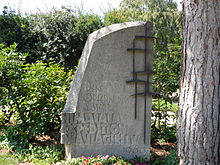Austrian Himalaya Expedition 1969

The Austrian Himalaya Expedition 1969 was an Austrian expedition to Dhaulagiri IV (7661 m) in the Nepalese Dhaulagiri Himal , a mountain range up to 8167 m high. When attempting the first ascent, five expedition members and one Sherpa disappeared without a trace.
Attendees
Richard Hoyer (* 1943) was the leader of the expedition , Kurt Ring (* 1933) was his deputy. The other three participants were Peter Lavička (* 1941), Peter Nemec (* 1943) and Kurt Reha (* 1948). They were all members of the Austrian Alpine Club , an association of high-performance mountaineers.
Her previous tours have included the Westliche Zinne -Northwand, Matterhorn -Northwand, Piz Badile -Northeastwand, Grand Capucin -Estwand, the Bonatti-pillar on the Petit Dru and the Walker-pillar on the Grandes Jorasses . There is also the Brenva flank on Mont Blanc , one of the highest ice and rock flanks in the Alps, and the Peuterey ridge on Mont Blanc, the longest combined ridge climb in the Alps. Further entries in her tour books included a Ushba crossing in the Caucasus , the Besengi Wall, the longest ridge in the Caucasus and a summit victory on Lenin Peak (7134 m).
As first ascents, they recorded among others, the Direct northeast wall of the Admonter Reichenstein stone that Nordwestverschneidung on Neunerkogel in the Dead Mountains and the Grazerweg by the direct east face of the plate bag .
expedition
The expedition set out from Vienna in August 1969 and was adopted by the future Foreign Minister Alois Mock , among others . After traveling for weeks they reached Pokhara , from where they marched with about 100 porters to the base camp at 3450 m, which they reached after 13 days on October 1st. They were at the foot of the south wall and planned the ascent over the east ridge and the south-west flank.
On November 9th, the fifth and last high camp was built at 6900 m, on the saddle between Dhaulagiri IV and an unnamed secondary peak in the west. That same evening, the base camp received a final message from Hoyer that the summit team was in good shape and that they would attempt the ascent over a snowy ridge at around 3 a.m. the next day. After that there was no more sign of life from Hoyer, Ring, Lavička, Nemec and Reha or the Sherpa Tensing Nindra. It is considered likely that they were caught in one or more avalanches. An intensive search with airplanes was unsuccessful. It is unclear whether any of them reached the summit.
The official first ascent of Dhaulagiri IV was finally made in May 1975 by a Japanese expedition under Tetsuya Nomura over the west side, but the summit team Shiro Kawazu and Etsuro Yasuda had a fatal accident on the descent.
Web links
- Victims of the Himalaya Expedition 1969 , Vienna Tourist Guide
- Dhaulagiri IV, Austrian attempt 1969 , summary of the Alpine Journal
- Dhaulagiri IV, 1969 , report from the Himalaya Journal
